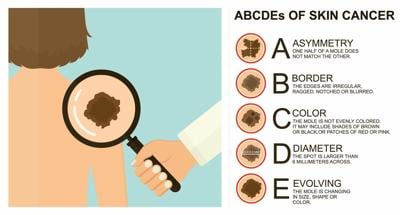Skin cancer is no joking matter, but the good news is it can be fairly preventable.
Russell Medical Cancer Center director George Miranda cautions that while squamous and basal cell cancers are largely treatable, melanoma is very dangerous. Melanoma doesn’t take long or doesn’t have to be very big before it becomes deadly because it moves into the lymphatic tissue. Another tricky thing about it is it can develop in areas where the sun rarely reaches.
In the case of melanoma, it’s important to do self-examinations and get a regular skin check. Skin checks can be done through most primary care offices and if there are enough signs, the primary care physician may refer individuals to a dermatologist.
Some things to look out for during a self-examination for any skin cancer are moles that are asymmetrical, a ragged border, discoloration, a large diameter and if the spot is evolving.
“Everybody has moles and spots or splotches,” Miranda said. “But if you notice anything that's different, that's grown, that maybe has become three dimensional, that maybe scabs up or bleeds.”
If you have any concerns, Miranda said, seek medical advice; it may be nothing but it’s best to get it checked just in case.
Meanwhile, basal and squamous are less dangerous but can spread if not treated. These skin cancer types are generally a by-product of too much sun exposure over time. Miranda said this is why sunscreen is so important, especially if you are at the beach or lake where you need to also reapply often.
Some other tools that help are wearing hats to protect the top of your head and cover up where you can. Squamous and basal cancers often show up on people’s shoulders, neck, top of the head and hands — common places that see sun exposure.
One of the big misconceptions is skin cancer affects only light skin individuals. While having fair skin can put someone at a higher risk, skin cancer still happens to Black people — including melanoma. Another high-risk factor can be dysplastic nevus, which are atypical moles.
Miranda said this isn’t to make anyone panic, but it’s to keep people informed so they can get diagnosis and treatment.
“I don't really want to say that skin cancer is not a big deal, because it is a big deal,” Miranda said. “But it's not the end. I tell everybody with cancer, just because you get diagnosed with cancer, doesn't mean you're going to die.”
Survivor rates with cancers in general have been rising. Miranda said when he started in the 1990s it was probably a 50% survivability rate in general and now it looks more like 68%.
As part of Skin Cancer Awareness Month, remember to wear sunscreen, cover up when you can, do self-examinations and get a regular skin check.

